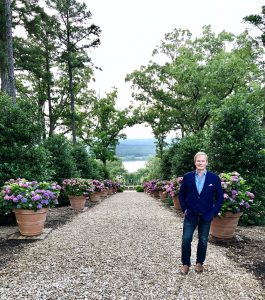THE GENIUS OF SITE: P. Allen Smith’s Moss Mountain Farm merges form and function with an eye on sustainability and conservation

WORDS / KODY FORD
PHOTOS / KATHERINE LAUGHLIN, P. ALLEN SMITH
Resting upon a hill overlooking the Arkansas River, Moss Mountain Farm serves multiple purposes—a tourist destination, a laboratory for conservation and, ultimately, a home. The estate was developed by P. Allen Smith, the best-selling author and television host. A graduate of Hendrix College and the University of Manchester in England, Smith has devoted his life to championing horticulture, design and sustainability. Moss Mountain Farm is an extension of these goals and principles.
The area was originally settled by the Quapaw Native American tribe in the 1200s. The Moss family built a farm and developed the land in the 1840s. The family grazed cattle, cleared rock and made way for arable land for crops. Some evidence of their efforts, such as terracing, can still be found today.
Smith built the over 400-acre farm in 2008 upon the 18th century idea of ferme ornée, meaning “ornamented farm,” in which a working farm also paid close attention to aesthetics. Philip Southcote’s Woburn Farm in England was an early example of this. Thomas Jefferson and John Adams toured Woburn in April 1786 while they served as the ambassador to France and England respectively. Jefferson took many elements he saw there and applied them to his home, Monticello, when he returned.
“We have tried to make an Arkansas example of ferme ornée,” Smith said. “[Moss Mountain] is a farm that demonstrates principles of good stewardship and land management, use of resources, water conservation, organic [farming methods] and tries to show a diversity of planting that is good for pollinators. The idea of form and function, the idea of beauty and utility—that’s really what [ferme ornée] is really about.”
Ferme ornée also plays a role in the architectural design of the buildings. A hierarchy of color gleaned from the landscape is used to designate the station of buildings and their use. The entry gates and main house are a buttery yellow, while utility buildings are painted a dark brown to match the oak trees with a green accent color to reflect the lichens in the area. The tinners red roofs of the buildings reflect the ferrous oxide found in the stones on the landscape.
While Smith drew inspiration from English estates, he applied his own 12 principles of design, which he outlined in his book P. Allen Smith’s Garden Home. The principles are broken down into two main categories—the framework or “bones” of the garden and the finishing touches. The principles related to the bones of the garden are enclosure, shape and form, framing the view, entry, focal point and structure. Those regarding finishing touches are color; texture, pattern and rhythm; abundance; whimsy; mystery; and time. 
Moss Mountain possesses a purposeful symmetry surrounding the main house. In the front yard a post oak dubbed Big Sister draws an invisible line through the center of the property. Smith said, “Everything is based on that tree; she was the guiding force. The house is centered on her. The backlawn and the two dependencies—the summer kitchen and the art studio—are symmetrical to that center line. You go to the lower terrance and the octagon follies are symmetrically placed and the line runs right through the center fountain down a path all the way until the precipice drops into the river.”
When designing the back garden, visitors should be led by the site. According to Smith, the poet Alexander Pope believed there was genius in every site, and it was the designer’s job to recognize the genius of that place. “Using [genius] in the 18th century definition—its bright spots, it’s gifts should be recognized,” Smith said.
His garden room concept can be seen throughout the grounds. The terrace gardens are designed on a very soft curve that can identified from the air, but when walking through the lower terrace visitors never really see the end. Smith utilized this to create a sense of mystery and expectation. In these gardens, he has focused on ways to divide the rooms with hedges and espalier fruit trees like Keiffer pears and Gala apples. Each room has a mix of perennials, bulbs or flowering shrubs and celebrates a certain way of using plants. The rose garden obviously highlights roses, but also shows examples of companion plants.
“We have tried to show the public [. . .] a mixture of vegetables and flowers arranged in a way that is hopefully visually compelling but at the same time beneficial and helpful,” Smith said.
Conservation of the land has been a major concern for Smith. Over the last 12 years, Smith and his team have worked to diversify the plant species at Moss Mountain. As a result, they have seen an increase in the number and variety of songbirds, as well as beneficial insects who act as natural pest control. Bees also play a very important role at the farm as natural pollinators. Their presence has played a huge role in how the gardens have flourished.
“We plant every year with pollinators in mind,” Smith said. “There’s a crisis out there regarding pollinators worldwide. What’s interesting is that there are 180,000 species of flowers and plants to be pollinated and roughly 1,200 of those are food crops. If you think about it, every third bite of food we eat as humans is the result of pollination. It’s a serious crisis.”
Practicing soil conservation to prevent erosion of topsoil is important at Moss Mountain, and they utilize retaining walls to divert water in different directions. They also harvest rainwater by creating retention pods, which they use to irrigate the gardens.
While most people do not have acreage on the scale of Moss Mountain, Smith’s principles and methods can be applied to even the smallest of outdoor spaces. “Creating intimate enclosure is a key to designing outdoors,” he said. “What makes you want to be in the space? Thinking about those spaces as one would a room—what does the floor look like, the walls? Are they an extension of the house? Are they hedges? Are they masonry? Are they loose or are they clipped? All those questions need to be answered and be within the spirit of the architecture. I’m a big believer in the garden should bow to the house in terms of style.”
Scale is the most important element of design in his opinion. Consideration of scale within a room is often missed or not thought of at all. He said, “Dimension, scale and proportion together bring harmony. It is an abstract idea, but it applies to any space no matter how large or small it might be. These are timeless and universal concepts.”
If your property has poor soil and lots of rocks, Smith recommends installing raised beds and covering them with plants that cascade off the edge and soften it, perhaps lemon thyme. He suggests mixing herbs and vegetables and flowers to make the beds more interesting and sustainable.
Visually, Smith says the garden room should be compelling and one should embrace the views when designing in the outdoor space. He added, “If you don’t have a view, screen it so you don’t have to see the neighbor’s Winnebago.”
Overall, the garden’s design should focus on two things—surprise and delight. “You want that wow moment, that gasp . . . I’m more interested in finding ordinary things and doing extraordinary things with them.”
PALLENSMITH.COM
The Idle Class printed a condensed version of this story in The Outdoors Issue.





Comments